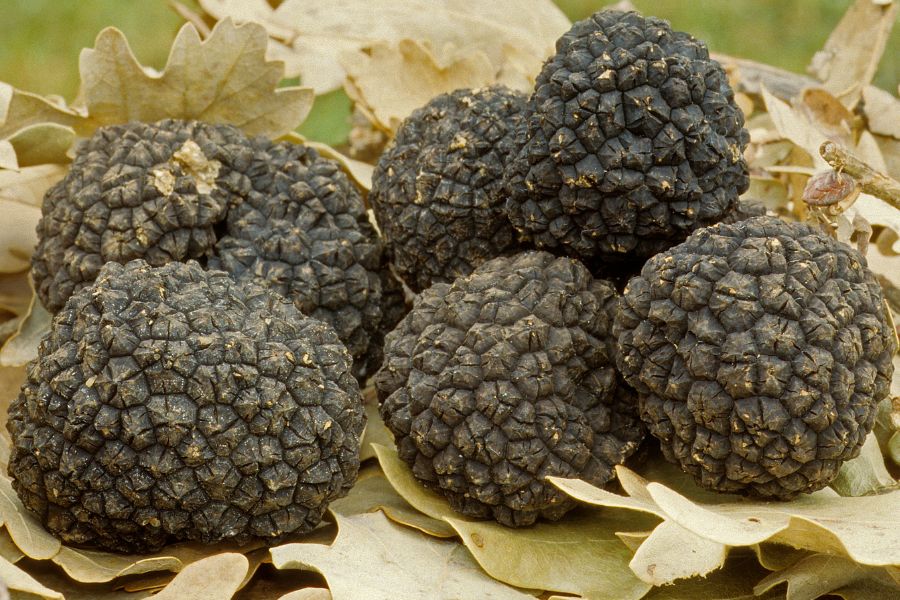Want to find truffles in Illinois? These rare fungi grow underground and can sell for lots of money. They are hard to find but looking for them is worth your time.
Truffles grow near certain trees in Illinois forests. Oak, hickory, and pine trees can be good places to look. Most Illinois truffles can be found in the southern parts of the state. The weather there helps truffles grow better. Fall and winter are when you should look for them.
You might need a trained dog to help find truffles. Some people use pigs to find truffles too, but dogs are easier to control. If you learn where to look and have some time, you can find Illinois truffles. Walking in the woods to find them is fun.
What We Cover In This Article:
- What Wild Truffles Look Like
- Truffle Lookalikes To Avoid
- Best Practices For Finding Truffles
- Where You Can Find Truffles Around The State
- Other Great Locations For Truffles
- When The Best Time Of The Year Is To Find Truffles
- The extensive local experience and understanding of our team
- Input from multiple local foragers and foraging groups
- The accessibility of the various locations
- Safety and potential hazards when collecting
- Private and public locations
- A desire to include locations for both experienced foragers and those who are just starting out
Using these weights we think we’ve put together the best list out there for just about any forager to be successful!
A Quick Reminder
Before we get into the specifics about where and how to find these plants and mushrooms, we want to be clear that before ingesting any wild plant or mushroom, it should be identified with 100% certainty as edible by someone qualified and experienced in mushroom and plant identification, such as a professional mycologist or an expert forager. Misidentification can lead to serious illness or death.
All plants and mushrooms have the potential to cause severe adverse reactions in certain individuals, even death. If you are consuming wild foragables, it is crucial to cook them thoroughly and properly and only eat a small portion to test for personal tolerance. Some people may have allergies or sensitivities to specific mushrooms and plants, even if they are considered safe for others.
The information provided in this article is for general informational and educational purposes only. Foraging involves inherent risks.
What Wild Truffles Look Like
The U.S. is home to several native truffle species that grow wild in forests across the country. Each one has its own unique scent, appearance, and preferred habitat. Here are the types of truffles you can find:
Oregon Black Truffles (Leucangium carthusianum)
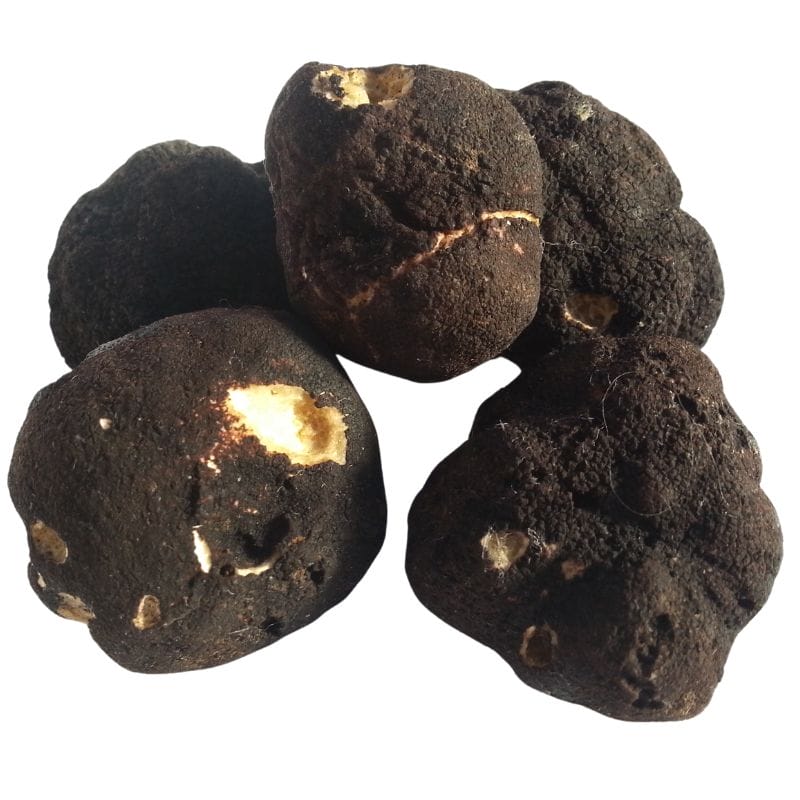
Leucangium carthusianum, also called the Oregon black truffle, grows in the Pacific Northwest and usually shows up around Douglas-fir trees. It’s a native species and one of the more well-known edible truffles from the region.
On the outside, it looks like a small lump of coal—dark black, kind of lumpy or warty, and sometimes slightly smoother in spots. They’re usually about the size of a golf ball, but they can be smaller or larger depending on the season.
Inside, the truffle is firm with a marbled pattern of gray and white veins running through it. When it’s fresh, it smells fruity, almost like pineapple, but the scent gets stronger and muskier as it ripens.
If you’re out looking for them, check in moist, shady forests with soft, loamy soil, especially where there’s a lot of moss or ferns. They grow just below the surface, so people often use trained dogs to help sniff out the ripe ones.
Compared to the Oregon white truffle, which is lighter in color and has a sharper, garlicky aroma, the black truffle has a deeper, more earthy smell. It’s also bigger and firmer than the southern U.S. truffles like Tuber lyonii, which tend to be smaller, paler, and grow around hardwoods like oaks and hickories.
Oregon Winter White Truffles (Tuber oregonense and Tuber gibbosum)
Oregon has two native white truffles that are starting to get more attention: the Oregon Winter White Truffle (Tuber oregonense) and the Oregon Spring White Truffle (Tuber gibbosum). They grow underground in forests and are prized for their strong, savory aroma.
From the outside, these truffles are small, roundish, and kind of bumpy, usually pale beige to light brown. Cut one open, and you’ll see a white interior that darkens with age, showing off a web of white veins when it’s fully mature.
The Winter White Truffle pops up from late fall into February, while the Spring White starts showing up around January and can last into June. They’re pretty similar, but the Winter variety is known for having a more powerful scent and flavor.
To find them, you’ll want to look in forests with younger Douglas-fir trees on the west side of the Cascades. Truffle hunters often check for loose soil or spots where animals have been scratching, which can be a sign there’s something below.
When fully ripe, both types give off a bold smell that’s often compared to garlic, cheese, or earthy spices. They’re usually served raw, shaved over dishes to add that truffle kick without losing any of the aroma.
Appalachian Truffle (Tuber canaliculatum)
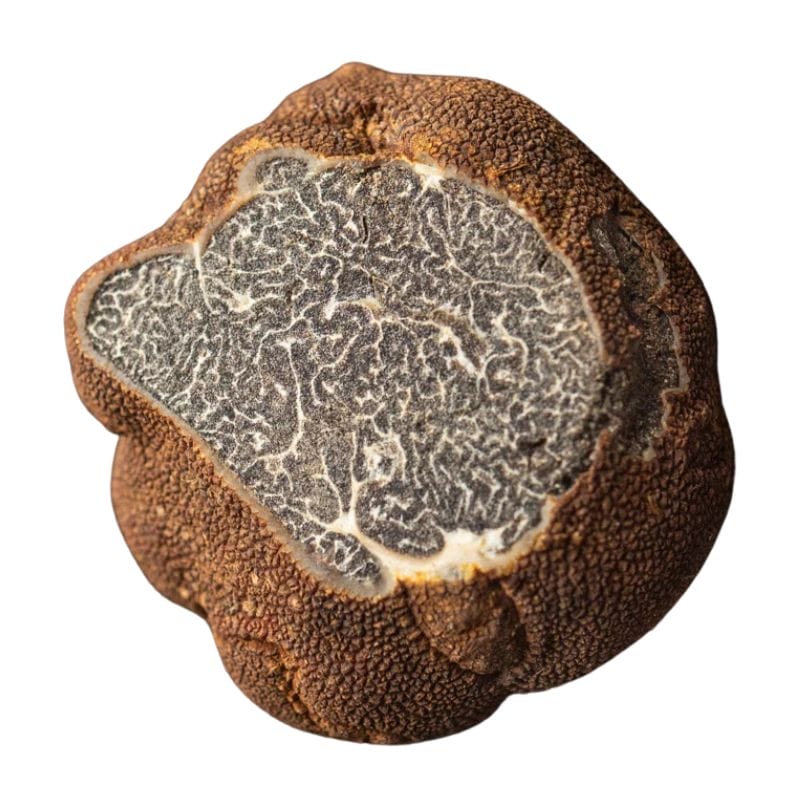
The Appalachian truffle, also known as Tuber canaliculatum, is a native North American truffle that’s slowly getting noticed. It’s about the size of a walnut and has a reddish-brown, bumpy outer surface that looks kind of like a rough, warty potato.
When you cut it open, the inside is firm and dark brown with thin white veins running through it like a marbled pattern. If it’s fully ripe, the smell is strong and earthy—some say it has a kind of nutty, funky aroma that stands out.
You can find these truffles in mixed hardwood forests, especially around oaks and pines, from late summer through fall. They grow underground, so look for spots where the soil is loose and animals like squirrels have been digging—sometimes that’s a good clue.
If you’re foraging, gently raking the top layer of soil near tree roots can help, but a trained dog or even a good nose makes it way easier. Once you know what to look for, the reddish color and bumpy skin are good signs you’ve found the right thing.
Compared to truffles like Tuber oregonense or Leucangium carthusianum, Tuber canaliculatum is more subtle in every way. Its smaller size and lighter scent mean you have to pay closer attention when foraging.
It’s also not as popular in the culinary world because it doesn’t pack the same punch in terms of flavor or aroma. Still, finding one can be rewarding, especially if you’re exploring different types of fungi in the area.
Desert Truffle (Terfezia and Tirmania spp.)
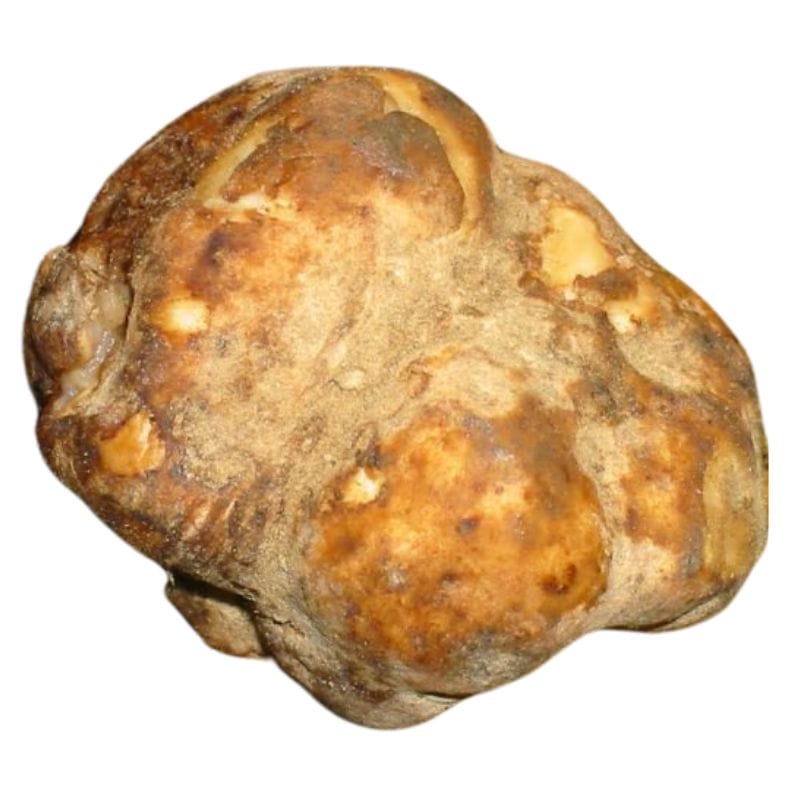
Terfezia and Tirmania are two types of truffles that are sometimes called desert truffles. These are a bit different from the truffles we usually think of, with their bold flavors and rich aromas.
These ones are a little more understated, but they’re fascinating in their own right. What makes them stand out is their ability to thrive in dry, harsh environments where you wouldn’t expect something so delicate to grow.
Unlike the earthy, intense aroma of black or white truffles, Terfezia and Tirmania truffles have a milder scent and flavor. They’re often described as nutty, with a hint of sweetness, but they lack the strong garlicky or musky notes you might associate with other truffles.
Their texture is also different—more firm and less oily than what you’d find with species like Tuber oregonense. They might not have the same culinary punch, but they’re still prized in traditional dishes, where their subtle flavors shine in simpler recipes.
When it comes to appearance, they’re easy to spot once you know what you’re looking for. They’re round to slightly irregular in shape, and their color can range from light beige to a reddish-brown, depending on the species.
The surface is usually smooth or slightly textured, without the rough, knobby look of a black truffle. Cut one open, and you’ll see a pale interior that’s often uniform in color, lacking the intricate veining you’d see in something like Leucangium carthusianum.
Pecan Truffle (Tuber lyonii)
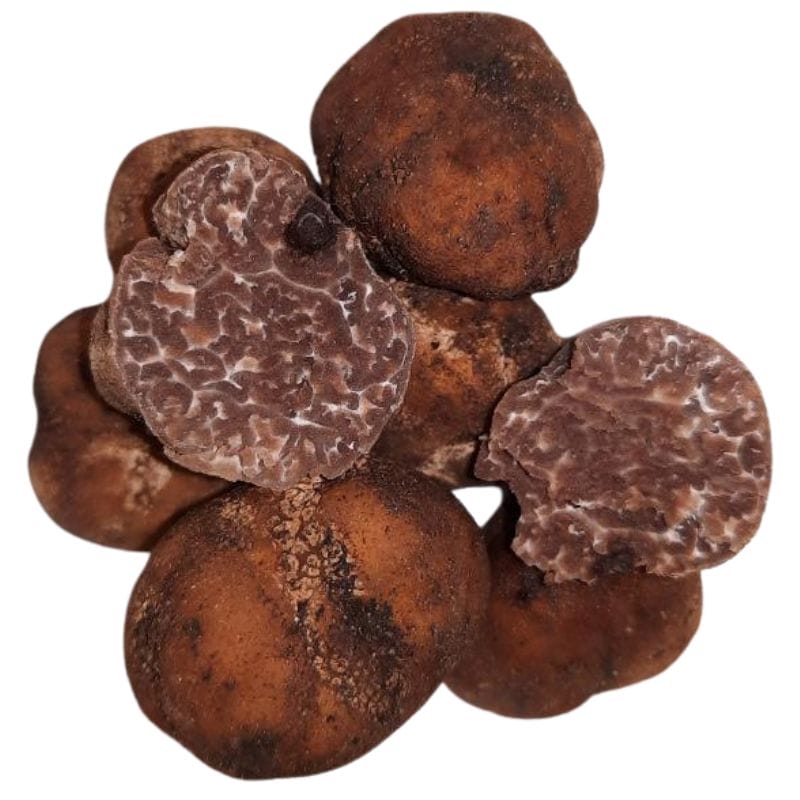
Tuber lyonii, also known as the pecan truffle, is a native North American truffle that grows underground near the roots of pecan trees. You’ll mostly find it in the southeastern U.S., especially in states like Texas, Georgia, and Mississippi.
On the outside, pecan truffles are round to lumpy and have a smooth, light brown skin that darkens as they age. They’re usually about the size of a marble or golf ball, and sometimes they even poke up slightly through the soil surface.
If you slice one open, the inside has a pretty marbled look—light tan streaks mixed with darker brown, almost like wood grain. The smell is earthy, nutty, and kind of warm, especially when they’re fully mature.
When you’re out looking for them, check under mature pecan trees or other hardwoods like oaks and hickories. Trained dogs can help sniff them out, but people sometimes spot them by looking for little cracks in the soil or raised areas near the tree’s base.
Compared to other U.S. truffles like the Oregon white truffle or the Appalachian black truffle, pecan truffles have a milder flavor and are more common in orchards. They’re a solid option in the kitchen—freshly sliced over pasta or mixed into butter—and they don’t come with the high price tag of their European cousins.
Truffle Lookalikes To Avoid
When you’re out hunting you also need to know about a few different fungi species that look very similar to the delicious truffles we’re after but are either inedible or not worth eating. Keep an eye out for:
Pine Truffles (Geopora cooperi)

Geopora cooperi is a fungus that can easily confuse someone new to truffle hunting. It’s sometimes called the pine truffle because it grows underground like a true truffle and often pops up near certain trees.
At first glance, it might seem like you’ve hit the jackpot, but this one is a false truffle, not something you’d want to eat or sell.
The easiest way to tell Geopora cooperi apart from real truffles is by looking closely at its structure. While true truffles have a smooth or slightly knobby exterior and a marbled interior, Geopora cooperi has a rougher, more irregular outer surface.
When it matures, it sometimes splits open, revealing a cup-like shape, which true truffles never do. Inside, it’s less dense and doesn’t have the intricate veining that makes real truffles so unique.
Another big difference is the smell. True truffles have a strong, rich aroma that’s earthy, sweet, or garlicky, depending on the species. Geopora cooperi, on the other hand, has a much weaker scent, and it’s not as pleasant or distinctive.
If you’re relying on aroma to identify your find, this one will give itself away pretty quickly. So, while it might look similar at first, a closer inspection will show it’s not the culinary treasure you’re hoping for.
Stinking Slime Truffle (Melanogaster ambiguus)
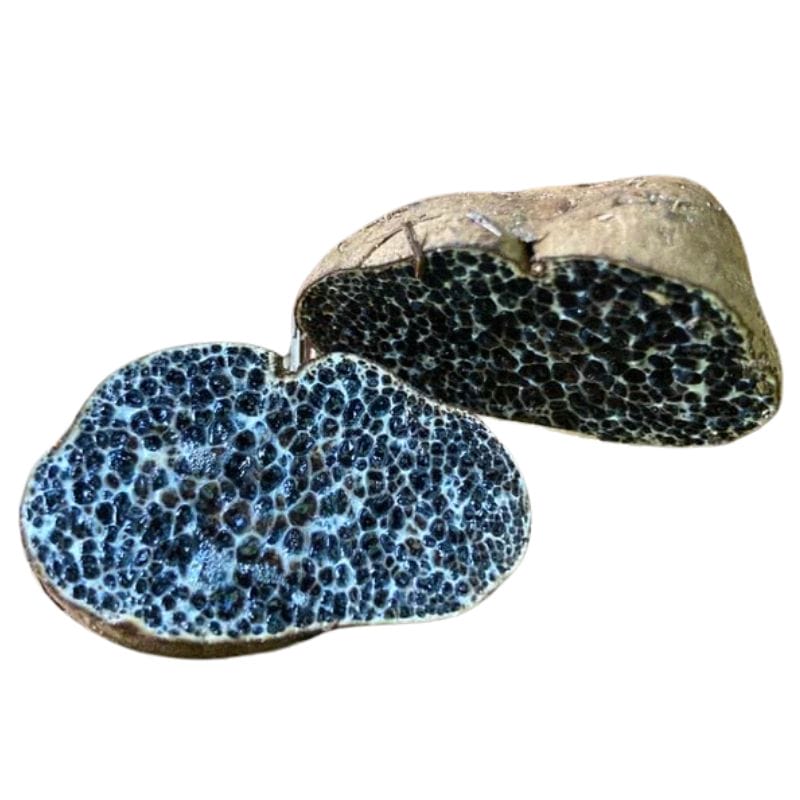
Melanogaster Ambiguus, because of their reddish-brown to dark brown exterior, might look like true truffles at first glance, but they’re quite different when you know what to look for.
The key difference is on the inside. When you cut open Melanogaster ambiguus, the interior is filled with flattened cells that have a shiny black gelatinous feel to them. Real truffles, on the other hand, have those beautiful marbled veins running through their flesh, almost like a web.
Another giveaway is the smell. While real truffles have a rich, earthy aroma that’s mouthwatering, Melanogaster ambiguus tends to have a much stronger, almost unpleasant odor—it’s not something you’d want to sprinkle on your pasta.
Earthballs (Scleroderma)
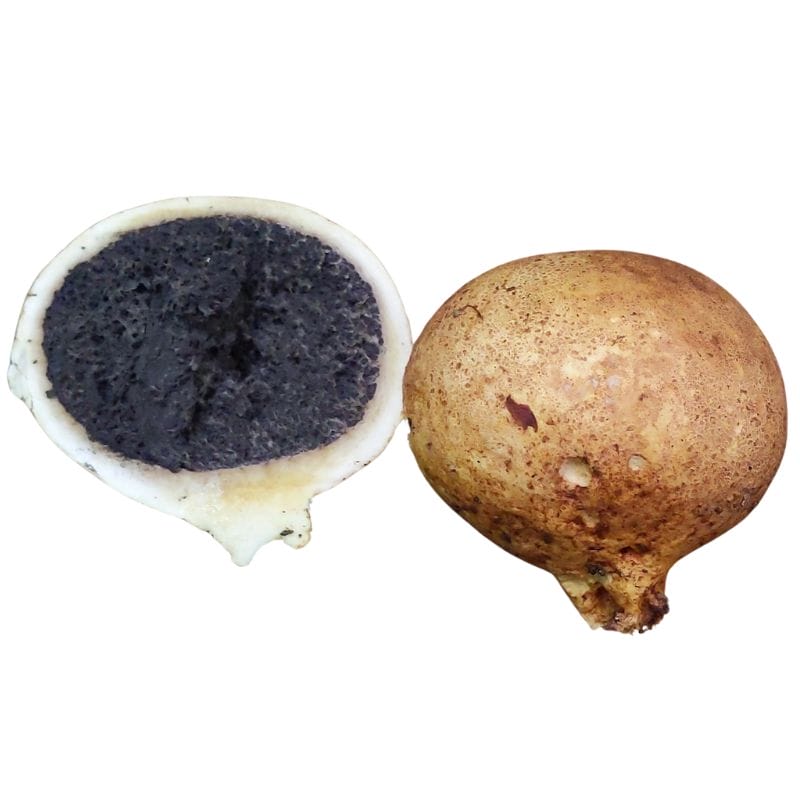
Scleroderma, commonly called earthballs, can easily fool someone who’s just starting out because they grow underground and have a round shape similar to truffles. But don’t be tricked—Scleroderma is not a true truffle, and it’s actually toxic, so it’s important to know how to tell the difference.
The first thing you’ll notice is the outer skin, which is thicker and tougher than that of most truffles. It can range in color from yellowish to dark brown, often with a rough or cracked texture.
If you cut it open, the difference becomes even clearer. While true truffles have a marbled interior with delicate white veins, Scleroderma starts out with a whitish inside that quickly darkens as it matures, turning black or purple with no marbling. It’s dense and solid, almost like charcoal in the later stages.
Another big giveaway is the smell. True truffles have a rich, earthy aroma that makes them so prized, while Scleroderma has little to no pleasant scent—some even describe it as musty or unpleasant.
Deer Truffles (Elaphomyces)
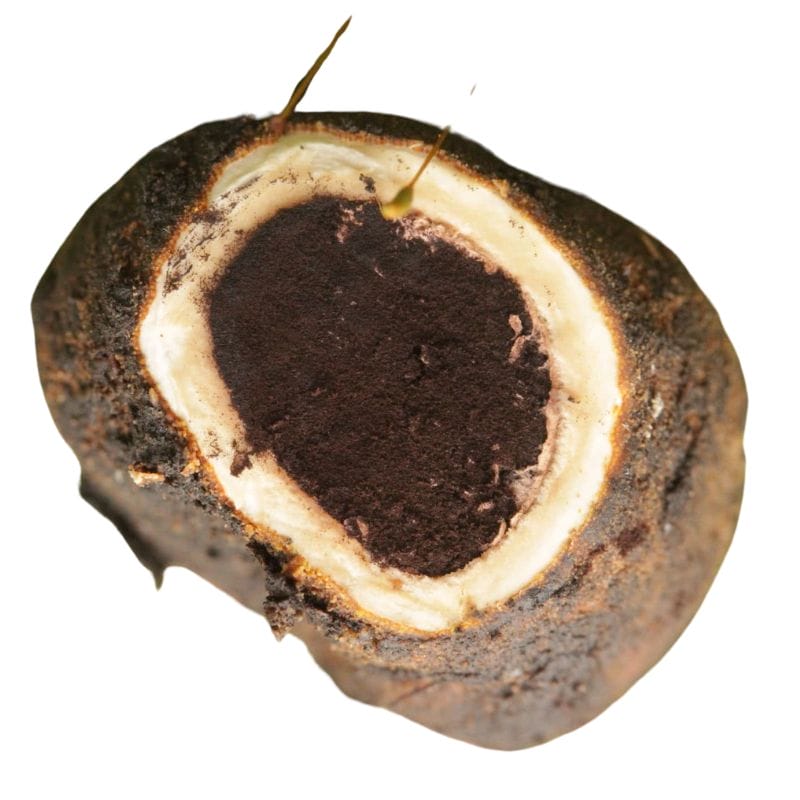
Elaphomyces, also known as deer truffles, look like true truffles at first glance, but they’re a whole different story. They’re called deer truffles because wildlife, especially deer and rodents, love to eat them. For us humans, though, they’re not edible—and definitely not what you want to mistake for a prized truffle.
Here’s how you can tell Elaphomyces apart from the real thing. First, they have a tough, warty outer surface that can range from pale tan to black, depending on the species and their age.
When you cut them open, the inside is solid and sometimes speckled or marbled, but not in the delicate, vein-like pattern you’d see in true truffles.
Their smell is also a big giveaway. Instead of the rich, earthy aroma of an edible truffle, Elaphomyces either has little scent or an odor that’s earthy but not particularly appealing.
Another thing to know is that Elaphomyces often grows deeper in the soil than true truffles, and they tend to have a harder, woodier texture.
Best Practices For Finding Truffles
Truffle hunting can be a rewarding adventure if you know the right tips and tricks. Here’s what you should keep in mind to improve your chances of finding these underground treasures:
Wait 10 to 14 Days After Heavy Rain
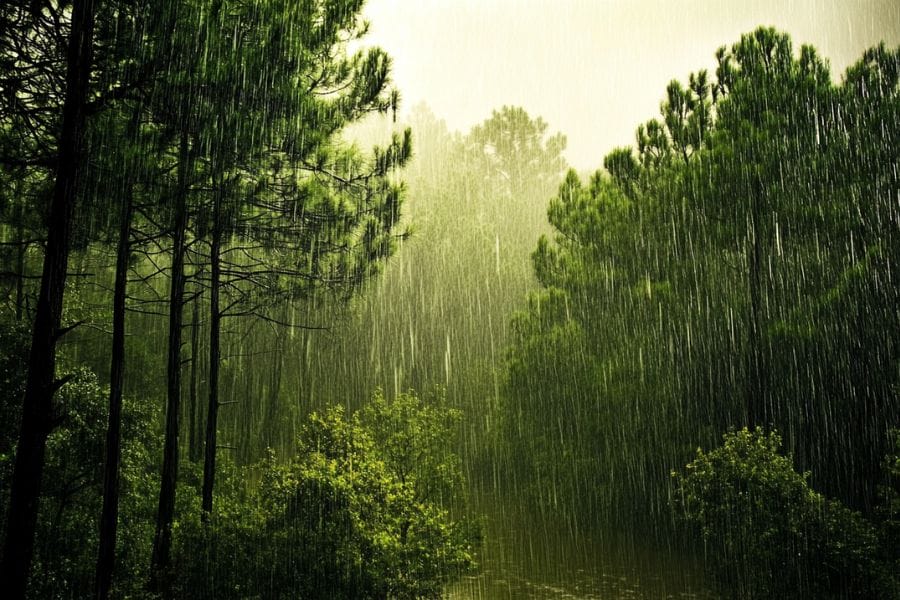
After a heavy rain, it’s best to wait about 10 to 14 days before heading out. This gives the truffles time to mature and release their signature aroma, making it easier for you (and your dog) to sniff them out. Rain helps truffles grow, but they don’t start giving off their scent right away.
As the soil warms up, the truffles get more aromatic, and the ground becomes looser, which makes digging easier without disturbing the environment too much. The timing is perfect to find truffles at their best—both in quality and in how easy they are to locate.
Find the Right Trees

Truffles don’t grow just anywhere—they have a special relationship with certain trees. You won’t find them under just any tree, so knowing which ones to look for can make all the difference. Some of the best trees to look out for are:
- Pines
- Douglas-firs
- Oaks
- Hazelnuts
- Cypresses
- Willows
For example, if you’re looking for Oregon white truffles, keep an eye out for Douglas-fir trees. California black truffles, on the other hand, are often found near oaks and hazelnuts. The soil around these trees also needs to be slightly alkaline, so it helps to know what kind of ground you’re walking on as well.
Watch for Wildlife Activity
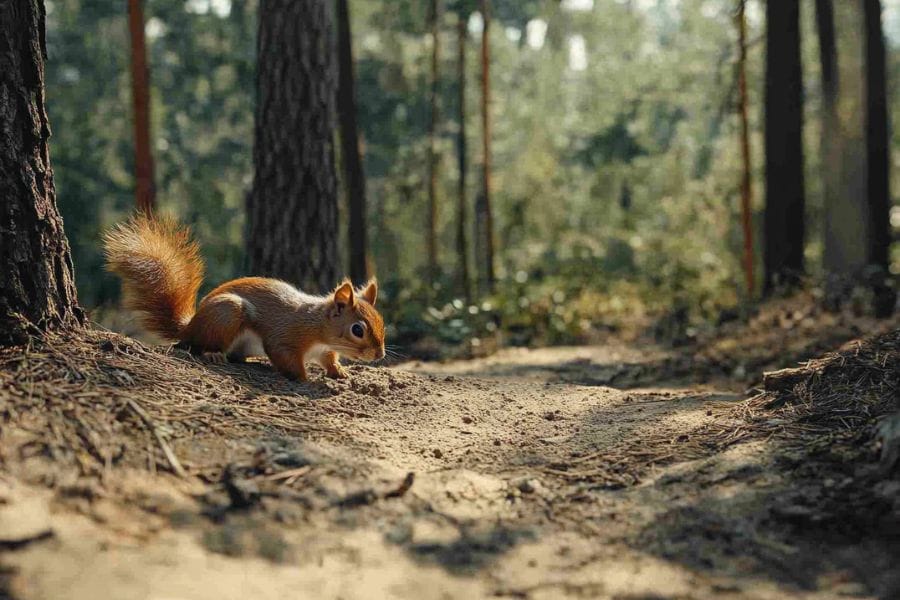
Animals like squirrels and chipmunks often help spread truffle spores, and sometimes their digging can lead you straight to truffles. While you won’t always find truffles in every pit animals dig (they also look for things like acorns or bulbs), fresh digs are a good clue. The more recent the pit, the better chance it has of leading to truffles.
Even though animals are a part of the truffle cycle, most hunters prefer using dogs to find the real treasure underground. Dogs have an incredible nose for truffles and can pinpoint their location much more reliably than any squirrel or chipmunk.
Get a Little Help from a Truffle-Hunting Dog
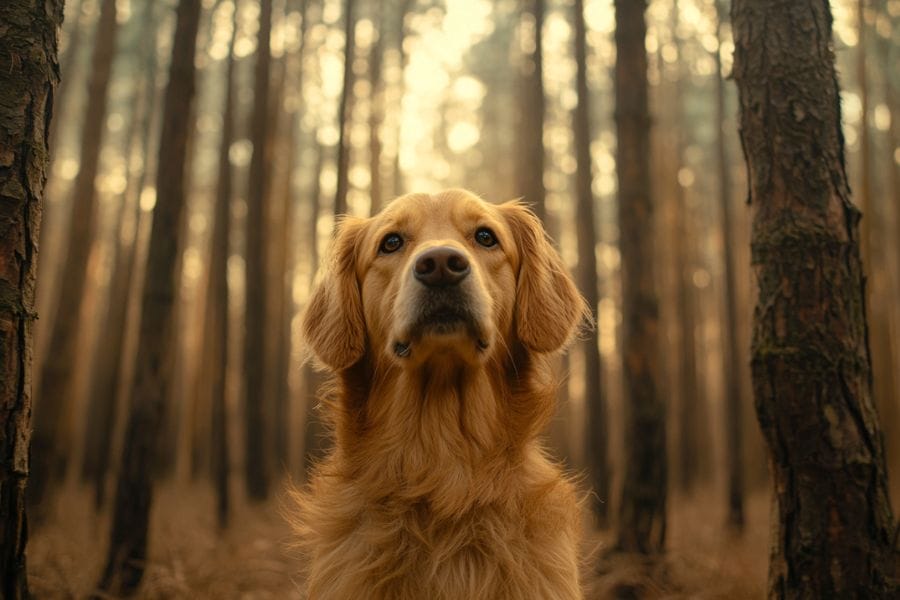
If you’re serious about truffle hunting, a trained dog can make your life a whole lot easier. Their sense of smell is extraordinary, and they’re trained to find mature truffles buried beneath the surface. Many truffle hunters swear by their dogs, and for good reason—they’re much more accurate than humans when it comes to sniffing out truffles.
If you don’t already have a trained dog, you can connect with local foraging groups or specialized trainers who offer truffle-hunting services. Some places even host events where you can see experienced handlers with their dogs in action. And if you’re feeling adventurous, you can train your own dog using truffle-scent kits and practice in a controlled space before hitting the woods.
Before you head out
Before embarking on any foraging activities, it is essential to understand and follow local laws and guidelines. Always confirm that you have permission to access any land and obtain permission from landowners if you are foraging on private property. Trespassing or foraging without permission is illegal and disrespectful.
For public lands, familiarize yourself with the foraging regulations, as some areas may restrict or prohibit the collection of mushrooms or other wild foods. These regulations and laws are frequently changing so always verify them before heading out to hunt. What we have listed below may be out of date and inaccurate as a result.
Where You Can Find Truffles Around The State
Now we’re going to go over five of the best locations for finding truffles. We’ll go a bit in-depth here and then provide a much longer list of other spots to try.
Shawnee National Forest
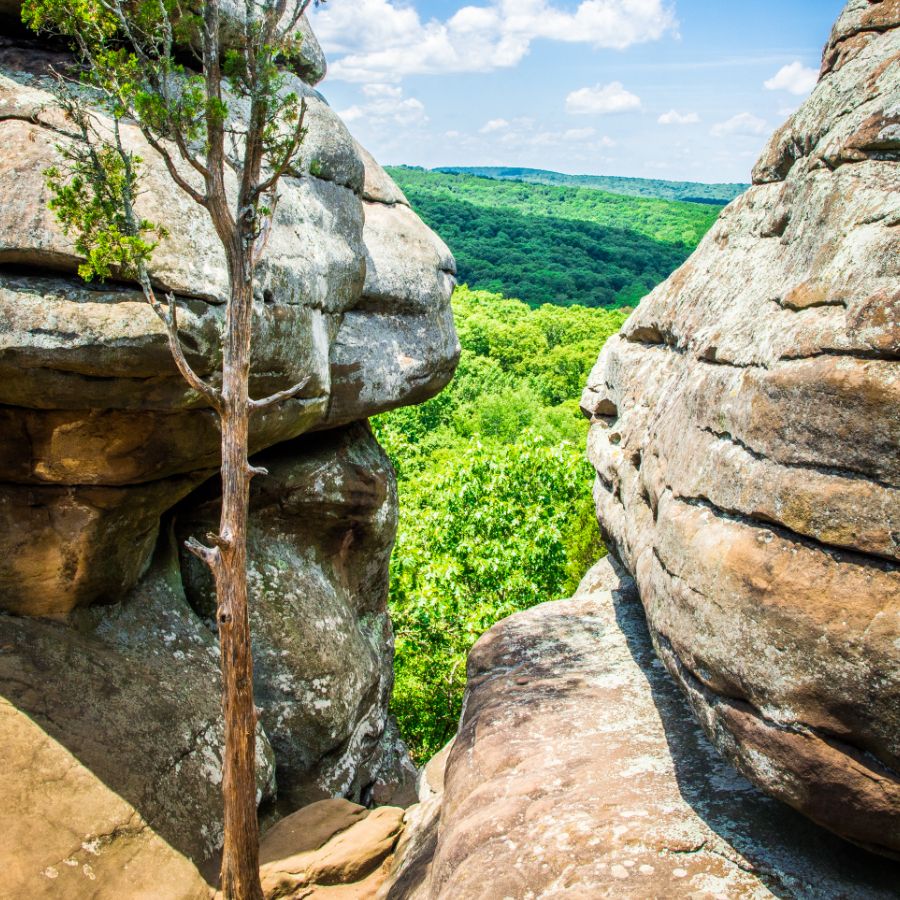
Shawnee National Forest spans across the southern tip of Illinois, covering over 280,000 acres of diverse landscape. This natural wonder features stunning rock formations, lush valleys, and an impressive variety of wildlife.
Look for truffles near the base of older oak trees, especially in areas with minimal undergrowth. The eastern section near Garden of the Gods is particularly promising because of its rich soil and mature tree stands.
The Hidden Springs area within the forest is also worth exploring, with its moist soil filled with organic matter.
Bring a small rake to gently move leaf litter without damaging the delicate mycelium network beneath. The Jackson Falls area has mixed hardwood forests that are less explored by casual hikers.
Trail of Tears State Forest
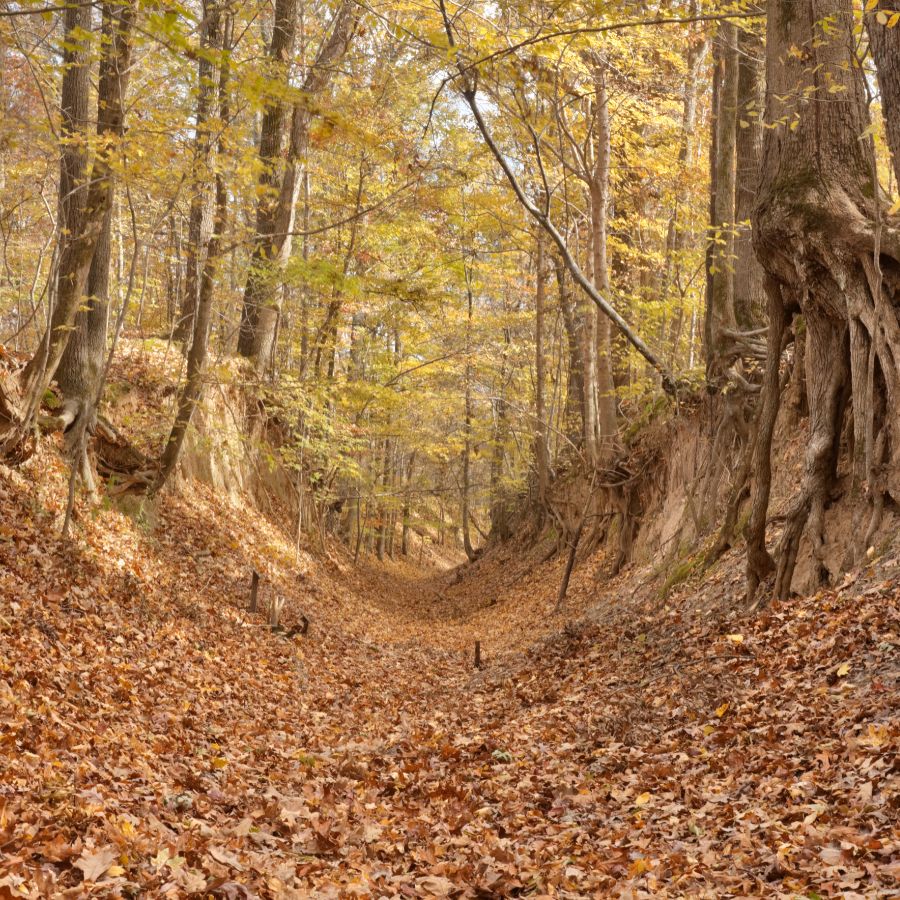
Trail of Tears State Forest is located in Union County in southern Illinois, offering 5,000 acres of ancient oak-hickory woodlands. Many trees here are over a century old, giving their root systems plenty of time to develop relationships with truffle mycorrhizae.
When hunting for truffles, focus on the ridges where beech and oak trees grow together. These areas tend to have the right soil chemistry and moisture levels that truffles prefer. Watch for areas where the ground shows slight bumps or cracks, as these might indicate truffles growing just below the surface.
The River to River Trail section has older growth trees with less human disturbence. It’s a good idea to visit after light rain when the scent of mature truffles is stronger and easier to detect.
Pere Marquette State Park
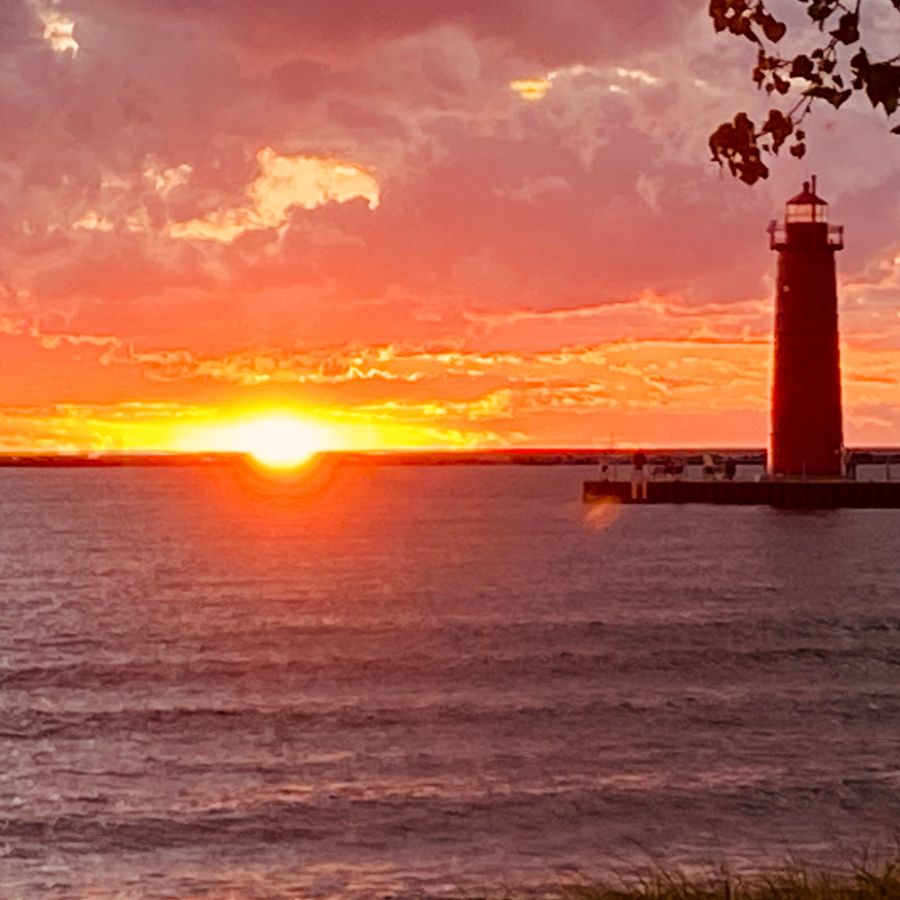
Pere Marquette State Park sits at the confluence of the Illinois and Mississippi Rivers near Grafton. This 8,000-acre park features limestone bluffs, wooded ravines, and diverse wildlife that create an ideal truffle habitat. The soil here is rich in minerals from the nearby rivers, contributing to the growth of various fungi species.
The forested hillsides on the eastern side of the park are less frequented by visitors and have some of the oldest trees. Look around the base of older hardwood trees, especially those in areas with good drainage but consistent moisture.
The McAdams Peak area has several promising spots where the forest floor is covered with a thick layer of leaf litter but minimal underbrush. The park’s varying elevations create different moisture zones, so check both higher and lower areas to find optimal growing conditions.
Siloam Springs State Park
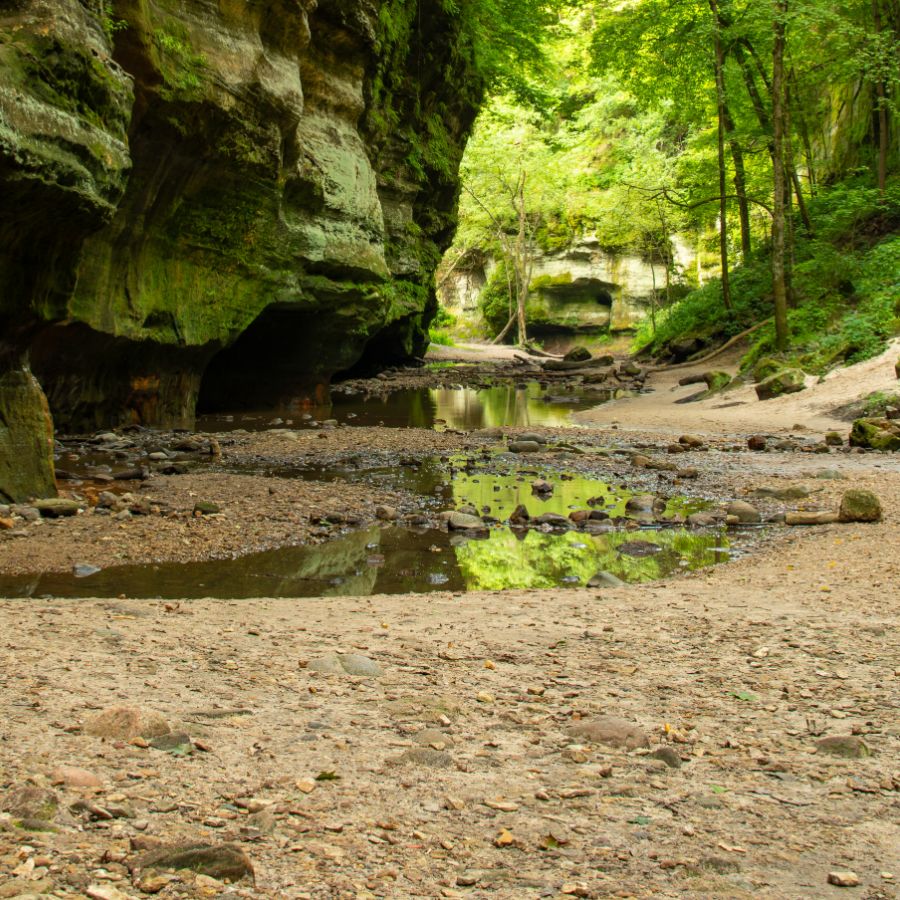
Siloam Springs State Park nestles in the rolling hills of western Illinois in Adams and Brown counties. Wildlife abounds in this 3,300-acre park, indicating a healthy ecosystem where fungi can thrive. The park’s many natural springs create areas of consistent moisture that truffle fungi need without becoming waterlogged.
Bring a small digging tool and look for small cracks or raised areas in the soil that might indicate truffles growing beneath. The best areas for hunting are the north-facing slopes with mature oak and hickory trees. These locations maintain moisture levels even during drier periods and have less dense undergrowth.
Check around fallen trees where the soil has been naturally disturbed, creating ideal conditions for truffle formation. The mixed forests near Crabapple Lake have the right combination of tree species and soil conditions that support various truffle varieties.
Kaskaskia State Forest
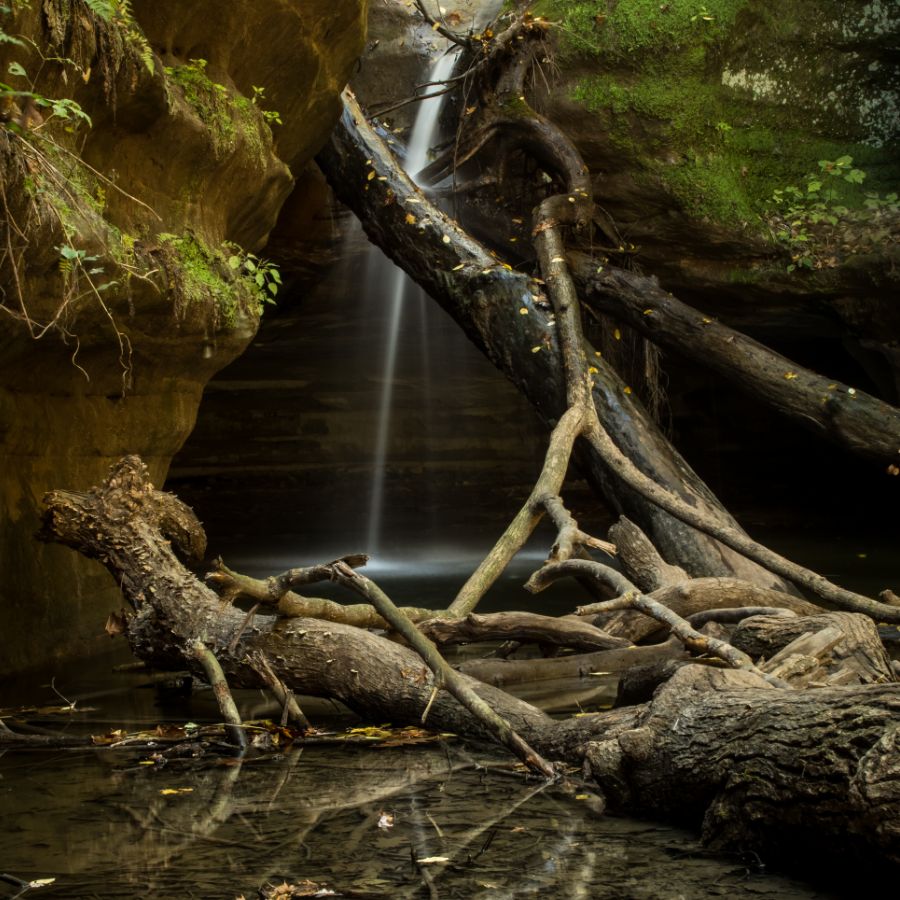
Kaskaskia State Forest is located in Randolph County in southwestern Illinois, about 55 miles southeast of St. Louis. This pristine forest preserve encompasses more than 1,400 acres of upland hardwood forest with minimal development.
The southwestern section of the forest has excellent spots with mature trees and minimal ground disturbance. Gently rake through the top layer of soil and leaf litter around the base of older trees, particularly in areas where there isn’t much competing vegetation.
Look for slight mounds in the soil or areas where small animals have been digging, as these can indicate the presence of truffles.
The Horse Trail area is less trafficked by casual visitors and contains some of the oldest tree stands in the forest. The forest has several ravines where moisture levels remain consistent even during drier periods, making them promising locations for truffle hunting.
Other Great Locations For Truffles
| Northern Illinois | Collection notes |
|---|---|
| Apple River Canyon State Park | Personal‐use mushroom foraging is welcomed after 1 p.m. during turkey season, in line with statewide rules. |
| Big River State Forest | You may gather edible fungi for home use anywhere outside the small dedicated nature-preserve unit. |
| Castle Rock State Park | Collect truffles in the open park zones; avoid the nature-preserve corridor where removal is barred. |
| Chain O’Lakes State Park | Seasonal “Eat-the-Woods” hikes highlight that personal mushroom harvests are allowed on regular park trails. |
| Franklin Creek State Natural Area | Truffles may be picked outside posted preserve patches and outside morning turkey-hunt hours. |
| Illini State Park | Visitors can hand-harvest edible fungi in the forests and river terraces after morning hunting hours. |
| Johnson-Sauk Trail State Recreation Area | Personal mushroom picking is permitted on all non-hunt days and after 1 p.m. when spring turkey hunts are active. |
| Kankakee River State Park | Walk any wooded floodplain and collect for home cooking so long as you stay outside dedicated preserve islands. |
| Lowden State Park | Truffle seekers may gather along oak bluffs and camp loops for personal meals. |
| Moraine Hills State Park | Edible fungi harvest is allowed across the moraine woods except during controlled turkey hunts before 1 p.m. |
| Rock Cut State Park | Foragers freely collect truffles around the hardwood coves after the morning hunt window closes. |
| Shabbona Lake State Recreation Area | Pick edible fungi under hardwoods surrounding the lake for non-commercial use. |
| Starved Rock State Park | Gathering is allowed on upland trails; skip the dedicated nature-preserve canyons. |
| White Pines Forest State Park | Small-scale personal harvesting of truffles is OK throughout the pine groves and picnic ravines. |
| Central Illinois | Collection notes |
|---|---|
| Clinton Lake State Recreation Area | Foragers may collect edible fungi in hardwood draws ringing the reservoir for personal meals. |
| Fox Ridge State Park | Hand-harvest truffles along ridge trails outside the dedicated nature-preserve spur. |
| Jubilee College State Park | Visitors often pick morels under the sugar maples after 1 p.m. during spring turkey season. |
| Kickapoo State Recreation Area | Truffle foraging is fine everywhere except the small nature-preserve tracts. |
| Lake Shelbyville – Eagle Creek State Park | Collect edible fungi in the oak uplands bordering the lake for home use only. |
| Lincoln Trail State Park | After the morning hunt window, visitors may gather morels and other truffles for dinner. |
| Middle Fork SFWA | Personal mushroom picking is permitted except during spring turkey hours before 1 p.m. |
| Moraine View State Park | Foragers work the upland oak groves for edible fungi once morning hunting closes. |
| Sand Ridge State Forest | The forest’s open oak ridges are accessible for non-commercial fungus gathering. |
| Sangchris Lake State Park | Visitors may pick truffles in shoreline woods for personal use after morning hunting hours. |
| Siloam Springs State Park | Mushroom harvesting is allowed on any open trail outside the nature-preserve ravine. |
| Walnut Point State Park | Collect edible fungi in beech-maple stands surrounding the lake for home cooking. |
| Weldon Springs State Park | Hand-gather truffles along the shaded lakeside trail for personal meals. |
| Southern Illinois | Collection notes |
|---|---|
| Beall Woods State Park | Visitors may forage for edible fungi outside the old-growth preserve core after 1 p.m. in turkey season. |
| Cache River State Natural Area | Mushroom hunting is expressly allowed on most units with no daily quota. |
| Carlyle Lake – Eldon Hazlet State Park | Edible fungi may be gathered throughout the oak groves for personal use only. |
| Cave-in-Rock State Park | Truffle hunters can pick along the river bluffs once morning hunts end. |
| Ferne Clyffe State Park | Regular visitors forage morels under tall tulip poplars each spring. |
| Giant City State Park | The park hosts annual “Meet the Morels” programs that underscore legal personal collecting. |
| Horseshoe Lake State Park | Visitors may gather edible fungi across the bottomland woods for their own table. |
| Lake Murphysboro State Park | Personal truffle foraging is welcomed throughout hardwood coves outside hunt hours. |
| Pyramid State Recreation Area | Foragers harvest mushrooms across reclaimed mine forests for non-commercial use. |
| Sam Dale Lake SFWA | Hand-gather truffles around mixed hardwood fingers for meals at camp. |
| Stephen A. Forbes State Park | Visitors commonly collect morels along the shaded lake-loop trail for home cooking. |
| Trail of Tears State Forest | Edible fungi may be harvested on any non-preserve slope once turkey hunts finish at 1 p.m. |
| Weinberg-King State Park | Foraging for personal-use mushrooms is permitted throughout the mixed oak-hickory uplands. |
When The Best Time Of The Year Is To Find Truffles
Fall and winter are the best times to look for truffles in Illinois. Most truffles start to grow after the summer heat ends. October through February offers the best chances to find them.
Cold weather helps truffles grow bigger underground. Look after a good rain when the soil is moist but not soggy. The ground should be cool to the touch.
Morning hunts work best because the truffle smell is stronger then. Avoid hunting in summer when the ground is too dry and hot. Also, skip days with snow or frozen ground since digging becomes too hard.
One Final Disclaimer
The information provided in this article is for general informational and educational purposes only. Foraging for wild plants and mushrooms involves inherent risks. Some wild plants and mushrooms are toxic and can be easily mistaken for edible varieties.
Before ingesting anything, it should be identified with 100% certainty as edible by someone qualified and experienced in mushroom and plant identification, such as a professional mycologist or an expert forager. Misidentification can lead to serious illness or death.
All mushrooms and plants have the potential to cause severe adverse reactions in certain individuals, even death. If you are consuming foraged items, it is crucial to cook them thoroughly and properly and only eat a small portion to test for personal tolerance. Some people may have allergies or sensitivities to specific mushrooms and plants, even if they are considered safe for others.
Foraged items should always be fully cooked with proper instructions to ensure they are safe to eat. Many wild mushrooms and plants contain toxins and compounds that can be harmful if ingested.

